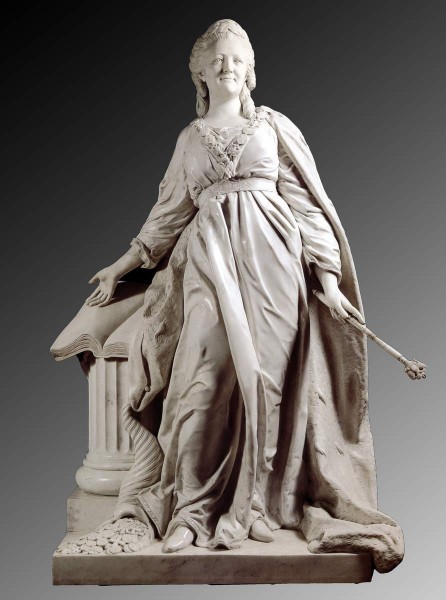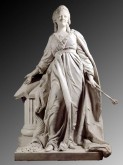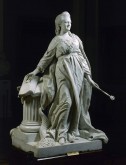Catherine II the Legislatress
1789
- Marble. 198 x 114 x 88
- Ск-306
Received in 1928
- Period 18th century
- CategoryPortrait, Allegory
- Share
This sculpture is an allegoric and an official portrait of Empress Catherine the Great. This sculpture of the Empress has an important place in Shubin’s work. This statue “Catherine the Legislatress” was created for a celebration organised by Grigory Potemkin in honour of the Empress at the Tauride Palace. A special rotunda was built in the Winter Garden for this statue. The white marble statue stands on a porphyry pedestal and is surrounded by greenery and gleamed by flickering candles. The appearance of the Empress, depicted wearing a tiara of laurel on her head, a chain on her chest and the Royal sceptre, is a combination of a ceremonial portrait and her individual features. The loose tunic and an ermine mantle does not conceal the proportions of the figure of the ageing woman. Shubin remained faithful to his realistic interpretation when he painted the ceremonial appearance of the Empress. For this work the sculptor was awarded the title of Professor in 1794.
Empress Catherine II (the Great; 1729–1796), née Sophie Friederike Auguste von Anhalt-Zerbst-Dornburg, was born in the Prussian city of Stettin. In 1744, she arrived in Russia as the bride of Grand Duke Peter Feodorovich, the future Emperor Peter III. That same year, she converted to Russian Orthodoxy and took the name Catherine Alexeyevna. She married Peter Feodorovich in August 1745. In 1754 she gave birth to an heir, the future Emperor Paul I. The relationship with her husband did not work out, and he planned to have her sent to a convent. In the summer of 1762 she led a conspiracy of Peter’s guards and overthrew him, becoming Empress. In the first years of her reign she adhered to a policy of “enlightened absolutism”, but after the peasant rebellion led by Emelyan Pugachev (1773–1775) and the French Revolution (1789), she was forced to toughen her regime. She led victorious campaigns against Turkey (1768–1774; 1787–1792) and Sweden (1788–1790). During her reign, the Crimea (1783), the Northern Baltic Sea, the Baltic states, the eastern part of Poland, and the Aleutian Islands became part of Russia. Russian settlements were established in Alaska, and Eastern Georgia was taken under the protection of Russia. Russia’s prestige in Europe increased greatly.



